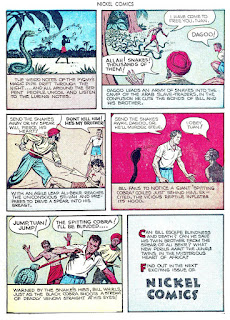If you are a geezer like me you remember when you could use a nickel to buy something. A candy bar, perhaps. I did occasionally pay a nickel for comic books when I bought coverless comics from a neighborhood drug store. (That was illegal, as I later found out. The covers had gone back to the distributor as unsold periodicals, and the store got credit.)
Nickel Comics #1 came out in 1940, with an eye-catching cover by Jack Binder. It also had 5¢ in large type on the cover. The magazine is 36 pages, half the industry’s 68 pages standard. It came out every two weeks. It only lasted eight issues. The Grand Comics Database explains it was an attempt to undercut other 10¢ comics, and it failed “due to distributors and newsstands refusing to carry a less profitable title.”
But Nickel Comics had the debut of Bulletman, who was a superhero for Fawcett. Bulletman, with his girlfriend, Bulletgirl, lasted for about nine years, so for the 1940s Bulletman and friends lasted longer than most superheroes.
The first story was written by Bill Parker (who had the habit of using unnecessary captions on the bottoms of many panels in a story), and drawn by Jon Smalle, and as a short biography from Lambiek says, “Jon Small was an artist from the UK, who lived and worked in the USA from the mid-1930s to the mid-1950s.” Small was also known as Smalle, maybe to make his name sound fancier. The second feature, “Jungle Twins,” was also written by Parker, drawn by Sven Elven, whose name reminds one of “seven eleven.” (A note that this story has outdated racial depictions. It is 80 years old, and attitudes of the time have also become outdated.) The third entry, “Warlock the Wizard,” is yet another entry in the line of comic book magicians, with no credit for writing or artwork.






































Plainly, the editors at Fawcett imagined the readers of Nickel Comics to be very childish. It at least made sense for them to imagine the average age of the readers as lower than that for 10¢ comic books.
ReplyDeleteI'd not realized how primitive were the first Bulletman story! It would have been rather better had Jim Barr not bulked-up over-night.
I was amused by Dagoo's line “The gods are saving us for a worse death.” The interaction with the giants under Steve's rule somewhat echoes that of Vincey and Holly with the Amahagger in She.
It is a bit surprising that only one throttling occurs in the Warlock story, and that by the villain. We've previously discussed “[The Traveller's Story of] a Terribly Strange Bed” by Wilkie Collins, in which a canopied bed is designed to suffocate the person sleeping in it.
This is utterly fantastic. Thanks Pappy- I'd long loved the covers of Nickel Comics I'd see either in books about comic history or in price guides but this is the first time I've gotten to enjoy the interiors. I feel I should actually send you a nickel now.
ReplyDeleteAlso, 'Warlock the Wizard' is such an entertainingly thorough name. It's like a character called 'Doctor the Physician' or something.
Thanks, Wm...Good catch on the redundancy in his name, but I still like the alliteration of Warlock's name.
ReplyDeleteThanks for the note.
P.S. When I was in the Army (many years ago) we had a doctor whose name was Docter. Doctor Docter. I thought he was lucky that physicians went into the service as officers at the time he was a Captain, so he was referred to by his rank. I'm sure that over his career, military or civilian, he heard many jokes about his name.
Daniel, coincidentally, I just read a short bio of Wilkie Collins in a 2011 New Yorker. I do remember the canopied bed story I showed, which came from an EC Comic.
ReplyDelete